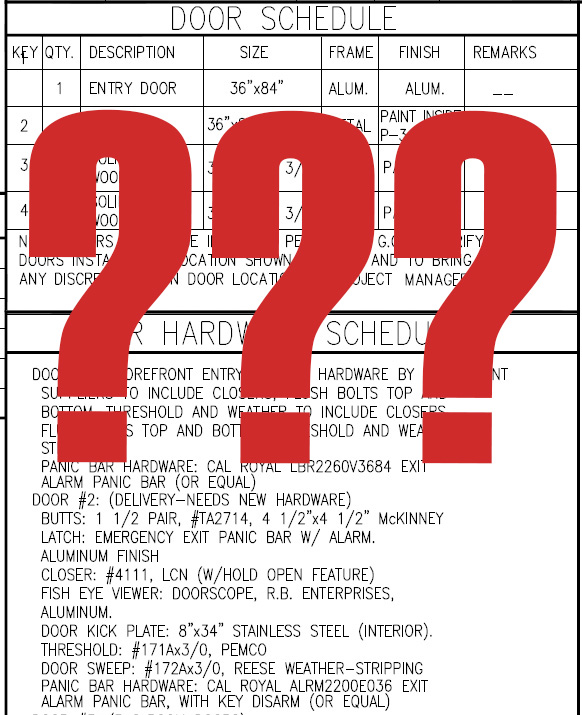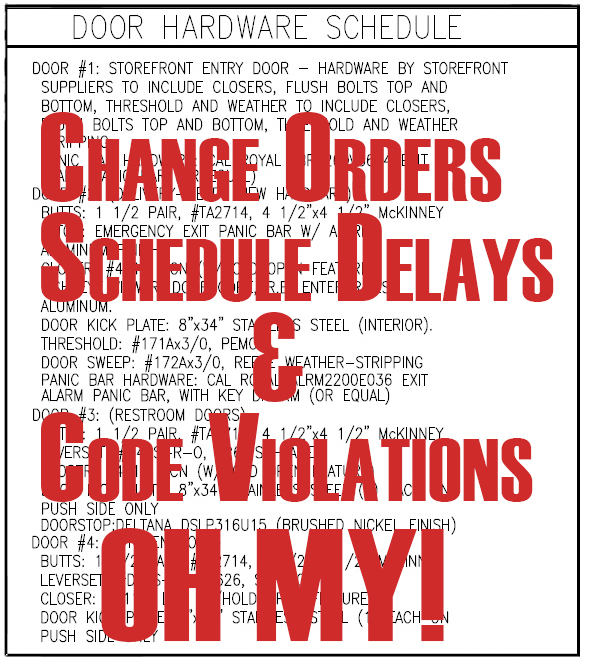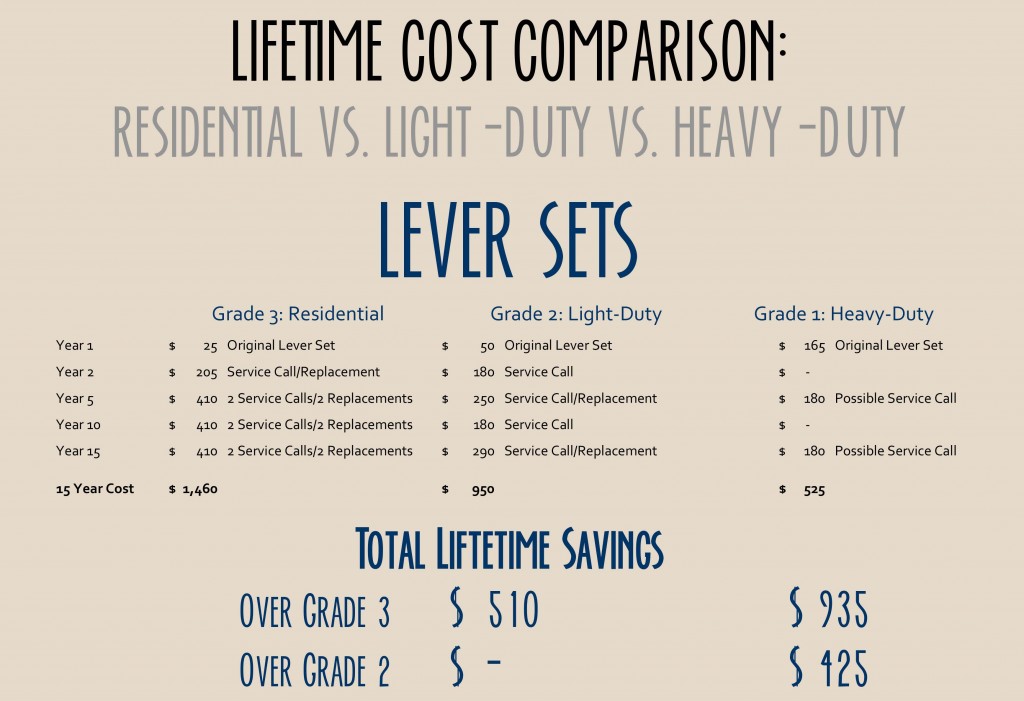How much time and money could you save by getting it right the first time?
 Your door schedule is the foundation of your facilities’ physical security – failure to get it right has a host of negative impacts – your bottom line, your schedule, and perhaps the most valuable, your time. From national chains employing a construction department of 50 people, to local one-man shows, we see these haphazard specifications pass our desks on a daily basis.
Your door schedule is the foundation of your facilities’ physical security – failure to get it right has a host of negative impacts – your bottom line, your schedule, and perhaps the most valuable, your time. From national chains employing a construction department of 50 people, to local one-man shows, we see these haphazard specifications pass our desks on a daily basis.
Without thorough attention to detail your facility ends up with two closers per opening and zero hinges. That won’t work – which means you’re looking at change orders, higher than anticipated cost, and delayed schedules. Specification consultation and/or review is an invaluable resource for getting your specs right and avoiding the issues caused by improper specifications.
Depending on the opening, traffic volume, location, and of course, local code requirements, there are dozens of things to be considered when compiling a door schedule. Over the years, we have become ‘experts’ at exit/rear/delivery door functionality, so I’ll focus on how to properly specify the entire opening for this application.
Door and Hardware Schedule – What Should Be Included?
A typical facility has at least seven openings. Entrance, Rear, Side, Storage/Utility, Women’s Restroom, Men’s Restroom, and an Office – there could be more, and sometimes less, depending on the size and function of the facility. You should have a door schedule for each opening. A complete and accurate door schedule for a rear/exit door should include each of the following:
- Location of the opening, Dimensions, and Handing
- Detailed frame type and specifications
- Detailed door type and specifications
- Hardware set to be referenced, general description of each item, and the quantity of each item.
- And finally, an architectural Drawing of Door
Door and Hardware Schedule – What Should Be Included?
 The hardware schedule is the place to detail specifics and quantities of each hardware piece. While some choose to outline the type of hardware required (i.e. privacy lockset), we recommend specifying the exact product you want for your facility. This should include manufacturer, model number, function options, and finish. Failure to do so leaves you at risk of receiving substandard hardware that will cause a lot of issues down the road (Don’t believe me? Check out this post on the lifetime cost associated with lower grades of hardware.) A complete and accurate hardware schedule will look similar to this one:
The hardware schedule is the place to detail specifics and quantities of each hardware piece. While some choose to outline the type of hardware required (i.e. privacy lockset), we recommend specifying the exact product you want for your facility. This should include manufacturer, model number, function options, and finish. Failure to do so leaves you at risk of receiving substandard hardware that will cause a lot of issues down the road (Don’t believe me? Check out this post on the lifetime cost associated with lower grades of hardware.) A complete and accurate hardware schedule will look similar to this one:
Notice this schedule includes the following components:
- Location of the opening
- Handing
- Dimensions and door/frame type
Quantities for each item
- Item Types
- Detailed Item Specifications
- And finally, finish specifications for each item
The hardware set is specific to one customer’s requests, the functions of the facility, and the opening location/function. In order for your door and hardware schedules to most efficiently serve their purpose, the hardware schedules in your architectural plans should be created especially for you, and must be done for every opening.
Door and Hardware Schedule The Impact of Incomplete Specifications
The impact of incomplete specifications has both short and long-term ramifications on your bottom line. Failure to include even one item from the door schedule spurs the following chain of events.
- The shipment is delivered to the site.
- It sits, unopened, for a week or two (on average) until the scheduled installation date.
- The site super, GC, or door technician starts opening boxes and realizes there aren’t enough hinges, or there are no closers, or there are too many locksets.
- Distressed phone calls are placed, and installation dates are pushed out.
- Change orders are requested, and an additional order is placed to be shipped overnight. (Read: you spend a lot of extra money and your turnover date rescheduled.)
While it takes a significant amount of time to put together a complete specification, the doors and hardware of your facility impact every patron and employee that enters your facility. This added time can ease the pains of change orders and delayed timelines as well as decrease the overall cost of your construction efforts. Remember, this only covers the items that should be included; it’s also important to specify hardware that is code compliant, durable to withstand the traffic of your facility, matches your overall brand image, and of course, falls within budget.
Door and Hardware Schedule – What Are You Risking By Not Verify the Integrity of Your Openings?
We know the chain of events that occur when the door schedule goes awry, but what happens when the specification is completed incorrectly? Although it’s not as easily recognizable, an incorrect hardware schedule can have ramifications just as damaging as their incomplete counterparts. Incorrectly specified parts run a high risk of violating local codes, breaking, and malfunctioning – all of which will cost your organization money for years to come.
Incorrect hardware schedules can be caused by a variety of issues ranging from software malfunctions to an uneducated or misinformed specifier. Specification consultation provides a second “set of eyes” to correct flaws before they affect your facilities.
Architectural Hardware Consultants (AHCs) spend years gaining their certifications, so it’s safe to assume there are numerous variables that must be evaluated for each product. The specific hardware functions needed will depend on a number of things, here are a few of the top items our AHCs look at when reviewing specifications:
- Facility’s traffic volume
- Local code
- Opening’s location and usage purposes
When these variables are assessed, AHCs will ensure that the following criteria are addressed for each opening.
Door and Hardware Schedule – Heavy Duty Hardware
If the door in question is located within a high-use commercial building, it should be accompanied by heavy-duty hardware. This is especially important on high-use doors; think public restrooms, entry doors, back of house doors, and offices. There are a number of ‘grades’ applied to hardware – grades 1, 2, and 3 – indicating the sustainability when faced with heavy usage. This applies to all hardware on an opening: frame, hinges, closer, threshold, lockset, lever, push/pull, panic hardware.
Failure to specify the proper grade in your hardware schedule will undeniably increase maintenance costs; grade three and even some grade two products are not made to withstand heavy traffic. The lifetime cost of a light-duty product will dwarf the initial cost of a grade one or two, not to mention the hassle of constant complications and replacements. Check out this comparison of the lifetime cost of a grade one closer versus a light-duty application leverset:
Now imagine, this cost spread out over the multiple openings of your facility; and now to the hundreds (or thousands) of facilities across the nation. That savings goes from significant to mind-boggling rather quickly, doesn’t it?
Doors that are susceptible to vandalism or extreme wear and tear should be outfitted in a completely different manner. Check out this post from my cohort, Katie; she outlines some great options for rear doors, which are usually the most vulnerable to this type of wear.
Door and Hardware Schedule – Knobs
A direct violation of ADA requirements, standard door knobs are not permitted in a commercial environment – just don’t do it. There are innumerable options to replace these code-defying eyesores. As a helpful hint, if a specifier includes a knob on ANY door within your hardware schedule, it’s time to find a new specifier.
Door and Hardware Schedule – Weatherstripping
If you had a hole in your door, you would certainly do something to plug it. Yet there are thousands of facilities with a sizeable crack around the doors. This gap is almost the equivalent air loss of a six inch hole in the middle of your door. Not only does it decrease the security of your building, but it increases your energy bill as well. Although including weatherstripping in the schedule should be a no-brainer, we see hardware sets missing this essential hardware element. Exterior doors need weatherstripping in order to maintain the opening’s integrity and of course, keep out the elements. Unwanted elements include bugs, windy drafts, and most importantly rainwater. Without weatherstripping, rainwater will wreak havoc on your door, frame, and threshold. As you know, once rust starts it’s hard to stop.
Door and Hardware Schedule – Hinges
All hinges are not created equal; functionality and durability vary by type and grade. Different doors necessitate different hinge types, so don’t constrain yourself to one manufacturer, model, or function type.
Consider the weight of a standard office door. Now consider the weight of a delivery door. Delivery doors are designed to withstand the most brutal of environments, think delivery drivers kicking the door open because their hands are full and brooms stuck in the hinge as a makeshift hold open – these needs require the door be MUCH heavier than a standard door.
If you were to install the hinges specified for the interior door on both of these doors, the delivery door would be sagging in no time which would cause a host of other issues with its hardware. If the same hinges are currently specified for all of your doors – an AHC or other door/hardware expert should evaluate it; there are likely a few upgrades or downgrades to be made. We recommend using a continuous or security hinge on exterior doors for added security and durability as these are applicable for any exterior door.
Door and Hardware Schedule – Weatherproof
Exterior openings require a special breed of hardware manufactured specifically for exposure to the natural elements, and hinges are no exception. While standard steel hinges will provide the desired security against unauthorized entry they don’t have a chance against withstanding repeated exposure to rain. Eventually, the steel hinges will rust causing the door to sag and pull away from the opening.
Stainless steel or ball bearing heavy duty hinges are marginally more expensive during initial installation, but they will more than pay for themselves over the lifetime of the opening. Failure to specify appropriate hinges will have a significantly higher price tag. Upon excessive wear and the unavoidable sagging and disengagement of the frame, you will need to remove the door and install new hinges. These types of projects are inconvenient and expensive as they require a professional door technician to physically remove the door from the opening.
Weatherproofing extends to every piece of hardware on an exterior door, not just the hinges. Pilfer guards, exit devices, and locking hardware are all available in a variety of weatherproof options. In order to ensure any exposed hardware continuously performs as expected and to maintain the highest level of security, the entirety of the opening should be weatherproof.
Finding hardware that is application-appropriate, code compliant, and fits your overall brand image all while fitting into your budget can seem overwhelming without the experience or knowledge of an industry expert. If you plan to go it alone, do ample research to make sure you’re getting the perfect hardware to meet your needs. If a third-party partner is handling the specification, you can still verify you’re including the right hardware – ask simple questions like: Is this code compliant? Is this weatherproof? What’s the standard lifecycle of that ___? You’ll likely gain some clout just for asking.
Google


We just couldnt leave your site before saying that I genuinely enjoyed the quality information you provide to your visitors? Will be again soon to check up on new posts
belstaff uk http://www.belstaffoutletonline.store